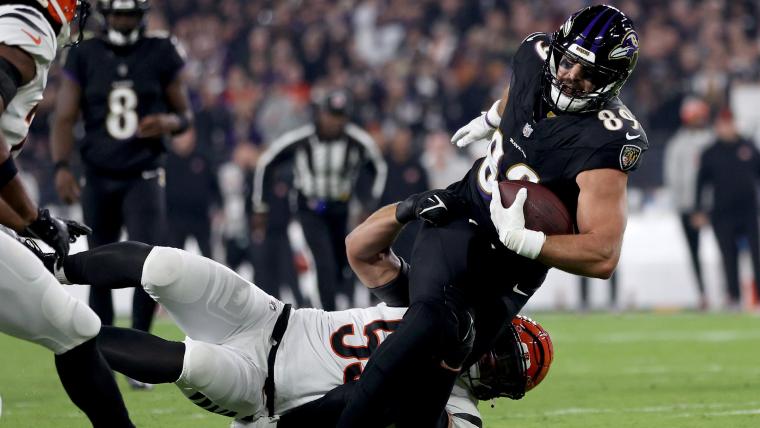The NFL’s Ban on Hip-Drop Tackles: A Controversial Move That Divides Players and Fans Alike, Echoing the Polarizing Debates of Our Time on Safety and Tradition in Sports
The NFL’s decision to ban the hip-drop tackle has ignited a firestorm of debate, drawing parallels to broader societal discussions about safety versus tradition. As the league moves into the 2024 season, the implications of this rule change resonate beyond the football field, touching on themes of player safety, the evolution of the game, and the ongoing struggle between offensive and defensive strategies.
The hip-drop tackle, as defined by the NFL, occurs when a defender wraps up a ball carrier and then rotates or swivels their hips, effectively unweighting themselves and dropping onto the legs of the ball carrier. This technique has been a part of the game for years, but its controversial nature has come to the forefront due to the increasing number of injuries associated with it. The league’s analysis of over 20,000 tackles revealed that the hip-drop tackle was responsible for lower extremity injuries at a rate 20 times higher than other tackling methods. This statistic alone underscores the urgency behind the NFL’s decision to implement the ban.
In March 2024, the league’s 32 team owners unanimously voted to prohibit the swivel hip-drop tackle, a specific variation that has garnered significant attention due to its dangerous implications. The rule change stipulates that any defender who executes this maneuver will incur a 15-yard penalty and grant an automatic first down to the opposing team. This decision was not made lightly, as it reflects a growing concern for player safety in a league that has faced increasing scrutiny over its handling of injuries, particularly concussions and lower body injuries.
The ban has been met with mixed reactions from players. While some, like Ravens tight end Mark Andrews, have expressed support for the change, citing the need to protect players from serious injuries, many defenders have voiced their frustration. They argue that the ban complicates the already challenging task of tackling in a game that is increasingly focused on offense. The NFL Players Association has also weighed in, suggesting that the new rule could lead to confusion among players, coaches, and officials alike.
The hip-drop tackle’s controversial nature is not just about player safety; it also touches on the broader themes of how the game is evolving. Football has long been characterized by its physicality, and defenders have traditionally relied on a variety of tackling techniques to bring down ball carriers. The introduction of new rules aimed at reducing injuries has sparked a debate about the essence of the game itself. Are we witnessing a shift towards a more sanitized version of football, one that prioritizes player safety at the expense of the sport’s inherent toughness?
This tension between safety and tradition is reminiscent of other societal debates, where the push for reform often clashes with established norms. Just as in discussions about gun control, healthcare, and public safety, the NFL’s decision to ban the hip-drop tackle highlights the complexities of balancing individual rights and collective responsibility. In this case, the rights of defenders to play the game as they see fit are weighed against the collective responsibility to protect players from harm.
As the 2024 season unfolds, the impact of the hip-drop tackle ban will be closely monitored. Officials will be tasked with determining what constitutes a hip-drop tackle, leading to potential inconsistencies in enforcement. Already, there have been instances where officials have missed calls related to the banned technique, resulting in frustration among players who feel they have been subjected to illegal tackles themselves. The potential for confusion and inconsistency raises questions about the effectiveness of the new rule and its enforcement.
Moreover, the ban has implications for how teams will strategize moving forward. Defenses may need to adapt their tackling techniques, leading to a potential shift in the dynamics of the game. Coaches will have to find new ways to train their players to tackle effectively without resorting to the now-banned techniques. This evolution could lead to a more cautious approach to tackling, which may alter the way the game is played at its core.
The NFL’s decision to ban the hip-drop tackle is a reflection of a larger trend in sports, where player safety is becoming an increasingly prominent concern. As leagues across the globe grapple with similar issues, the NFL’s actions may serve as a bellwether for how professional sports adapt to the evolving landscape of player health and safety. The conversation surrounding the hip-drop tackle ban is likely to continue, as players, coaches, and fans navigate the complexities of a game that is both beloved and fraught with risk.
In the end, the debate over the hip-drop tackle encapsulates the ongoing struggle within the NFL and beyond: how to preserve the integrity and excitement of the game while ensuring the safety and well-being of its players. As the league moves forward, the ramifications of this decision will be felt not only on the field but also in the broader context of sports culture and society at large. The hip-drop tackle ban is just one chapter in a much larger narrative about the future of football and the delicate balance between tradition and safety.

What is a hip drop tackle? Explaining why NFL banned controversial defensive play originally appeared on The Sporting News.
Add The Sporting News as a Preferred Source by clicking here.
Tackling in the NFL looks a bit different than it did last season.
After debate over the past few years on whether the hip-drop tackle should be banned, the league announced in March that it would, in fact, be removing the technique as a legal play. It was one of multiple rule changes that went into effect in the 2024 season.
The change was supported by some players, but it left others — especially defenders — confused about what they can and can’t do.
The Sporting News has you covered on what exactly a hip-drop tackle is and why the NFL banned a version of it.
What is a hip-drop tackle?
According to a press release from the NFL itself, a hip-drop tackle "occurs when a defender wraps up a ball carrier and rotates or swivels his hips, unweighting himself and dropping onto ball carrier’s legs during the tackle."
It became controversial over time as more players were being injured from the same tackling technique. However, it should be made clear that the league specifically banned the "swivel" hip-drop tackle, which isn’t used nearly as often as the normal version.
MORE:How Jacoby Brissett went from failed Colts starter to Cardinals backup
NFL competition chairman Rick McKay clarified that the rule change doesn’t ban the hip-drop tackle in general, just if the defender "rotates or swivels" the hips of the ball carrier.
When determining if a defender should be punished for a hip-drop tackle, officials will review two actions: If the defender "Grabs the runner with both hands or wraps the runner with both arms" and also "Unweights himself by swiveling and dropping his hips and/or lower body, landing on and trapping the runner’s leg(s) at or below the knee."
Examples of the now-banned style of tackling were shown in an NFL press conference in March.
Here’s the video the NFL just showed in a press conference of what are now banned swivel hip-drop tackles (with NFL executive Jeff Miller speaking in the background). pic.twitter.com/Y4H8h6pQkW
— Tom Pelissero (@TomPelissero) March 25, 2024
The league’s 32 team owners unanimously voted on the ban. Moving forward, a swivel hip-drop tackle will result in a 15-yard penalty and automatic first down for the offense.
League representatives have said they’ll continue to provide context to teams on what is and isn’t banned so they can adjust to the change.
Why did the NFL ban hip-drop tackles?
NFL executive vice president Jeff Miller previously said that 15 players missed time last season because of the now-illegal technique — the reason it’s banned is simply because of the injury risk it causes.
In its release about the rule change, the NFL said it analyzed over 20,000 tackles over the 2022 and 2023 seasons and came to the conclusion that the hip-drop tackle causes "lower extremity injuries" 20 times more often than other tackling techniques.
One recent example of how the method has harmed a player is with the Ravens‘ Mark Andrews. In November 2023, Bengals linebacker Logan Wilson brought Andrews to the ground with a hip-drop tackle that left him injured afterward.
#Ravens Mark Andrews – Video suggests high ankle
Ankle didn’t bend that severely, but the prolonged force while it’s being dragged suggests at least moderate severity.
Not impossible, but would be surprised if he returns.
— Deepak Chona, MD. SportsMedAnalytics (@SportMDAnalysis) November 17, 2023
Andrews missed the next two months of Baltimore’s season after undergoing surgery for a fractured fibula and ligament damage.
Per ESPN, Andrews said later on that he was happy about the league banning the swivel hip-drop tackle and that "defenses can find a way to get around that."
"Taking that tackle out of the game is not a bad thing," Andrews said. "You look at the last five years, there’s been a lot of big injuries with that. So just bringing the awareness to that type of tackle, I think is good."
Andrews later returned to action for the Ravens in the AFC Championship game, where they fell to the Chiefs.
The banning of the hip-drop tackle drew criticism from many players in March, mostly the ones doing the tackling themselves — defenders.
NFL players reacting to the league banning the hip-drop tackle… https://t.co/fFzGJqe7oOpic.twitter.com/qSChmUGfP4
— Ari Meirov (@MySportsUpdate) March 25, 2024
The NFL Players Association released a statement about it as well, saying the change would "cause confusion" for everybody, whether players, coaches, officials, or fans.
Our statement on the swivel hip-drop tackle. pic.twitter.com/8mzhjtPgKu
— NFLPA (@NFLPA) March 20, 2024
Teams have had since March to adjust how their defenders tackle, but there has already been debate about whether something should or shouldn’t be considered a hip-drop tackle. Officials have missed a few hip-drop calls in 2024, leading to some players expressing anger over being injured by "illegal" tackles.
Just because the play is banned doesn’t mean it isn’t happening in the 2025 season. Washington Commanders linebacker Frankie Luvu was suspended for one game after Week 9 for his third hip-drop tackle of the season, per NFL Network’s Tom Pelissero. That marked the first suspension after the new rules had been instituted. The linebacker was fined after the first two instances, and has the chance to appeal as explained in a league statement.
